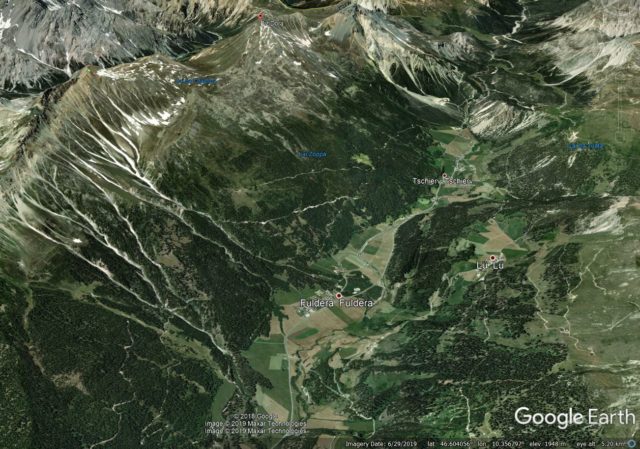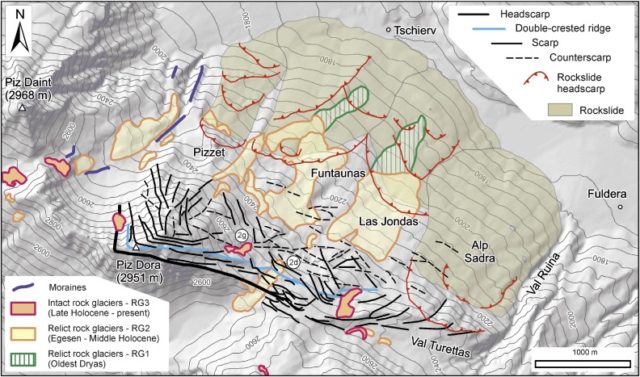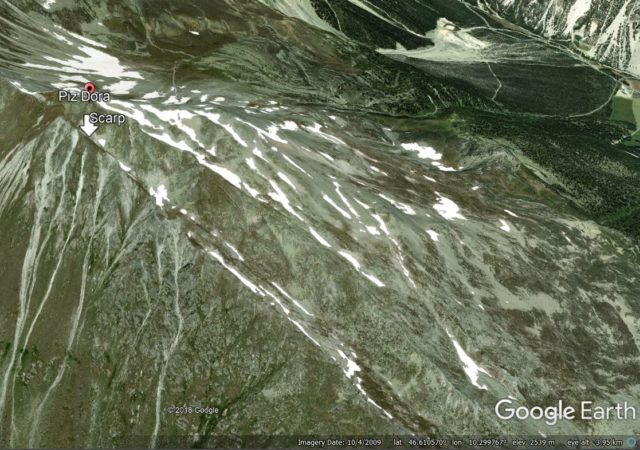22 November 2019
Deep-seated gravitational slope deformations: Piz Dora
Posted by Dave Petley
Deep-seated gravitational slope deformations: Piz Dora
Deep-seated gravitational slope deformation (DGSD) is one of the most poorly recognised, but most dramatic, types of landslide. Mauro Soldati defined them as follows:-
A deep-seated gravitational slope deformation (DGSD) is a gravity-induced process affecting large portions of slopes evolving over very long periods of time. A DGSD may displace rock volumes of up to hundreds of millions of cubic meters, with thicknesses of up to a few hundred meters…Deep-seated gravitational slope deformations (DGSDs) are not considered hazardous phenomena because they evolve very slowly. However, they must not be neglected when defining slope instability in a territory and the related hazard implications. Despite their slow deformation rates, DGSDs may cause damage to surface and underground (e.g., tunnels) structures. In addition, they may evolve into faster mass movements or favor collateral landslide processes.
A really nice example is described in an article in Engineering Geology (Agliardi et al. 2019) at Piz Dora in Switzerland. This landslide, which is located at 46.601, 10.350, is shown very nicely in the Google Earth image below:-

Google Earth image of the Piz Dora deep-seated gravitational slope deformation in Switzerland. The view is towards the west.
.
There is an excellent interpretation of the geomorphology and structure of the Piz Dora DSGSD is provided by Agliardi et al. (2019):-

A geomorphologic and morpho-structural map of the Piz Dora deep-seated gravitational slope deformation. Map from Agliardi et al. (2019).
.
As the map shows, the entire mountain side is moving on a deep-seated shear surface (or on multiple shear surface), creating a set of scarps and counter scarps high on the hillside. One of the largest ones is seen below:-

A counter scarp on the Piz Dora deep-seated gravitational slope deformation. Image from Google Earth.
.
Downslope from the scarp is a large displaced mass. Smaller scarps extend across the slope – at the main peak (Piz Dora itself, there is a pin to mark it in the first image) the scarps extend right the way through the crest of the slope:-

Google Earth image of the rear scarps of the Piz Dora deep-seated gravitational slope deformation.
.
The lower part of the mobile slope consists of a series of smaller, but from insignificant, rockslides, mostly covered in forest.
Agliardi et al. (2019) have measured the rate of movement of the Piz Dora deep-seated gravitational slope deformation. They found that, as is usual for this type of landslide, the mass creeps continuously at low rates. Movement rates vary across the landslide, with a maximum velocity in the order of 30 – 100 mm per year.
These types of landslides are very common in high mountain areas. Because they do not generate significant levels of hazard, they are poorly investigated and are rarely reported. However, they are one of the most fascinating types of landslide, and they deserve more attention.
Reference
Federico Agliardi, Federico Riva, Marta Barbarano, Stefano Zanchetta, Riccardo Scotti and Andrea Zanchi. 2019. Effects of tectonic structures and long-term seismicity on paraglacial giant slope deformations: Piz Dora (Switzerland). Engineering Geology, 263, 105353. https://doi.org/10.1016/j.enggeo.2019.105353.


 Dave Petley is the Vice-Chancellor of the University of Hull in the United Kingdom. His blog provides commentary and analysis of landslide events occurring worldwide, including the landslides themselves, latest research, and conferences and meetings.
Dave Petley is the Vice-Chancellor of the University of Hull in the United Kingdom. His blog provides commentary and analysis of landslide events occurring worldwide, including the landslides themselves, latest research, and conferences and meetings.
If I take only one thing away from this post is that the structural geology in this region must be very complicated (unfortunately I cannot access a full version of the paper to read what the authors describe).
Given that similar features appear to be present in the opposite side of the valley, and in the valley to the NE of this landslide, there seems to be a lot of slope movement going on. It is also very interesting that the features described in the post also seem to extend further to the WNW along the valley slopes. Although the Piz Dora is the more studied landslide, my guess is that there is a sginficantly larger landslide mass, or larger number of landslide masses, in this valley. Not to mention the adjacent valleys.
I see the same features all the time in my neck of the woods – SW British Columba, Canada – and wonder all the time how safe my home is, despite moving from the valley bottom into the hills to be protected from the Cheekeye Fan and liquefaction-prone valley bottom sediments.
Truly remarkable landscape, and I note Val Ruina (aiming at Fuldera) has at least 3 dozen check dams in various stages of repair visible along it. Fortunately, the channel is constrained by tall natural levees from an earlier time.
Dear Sir, Dave Petley
Good afternoon from Narayangopal Ghimire, Kathmandu, Nepal.
I know you since 1996 and continuously assessed your research contributions.
Now, I am working in the Central Department of Geology, Tribhuvan University, Kathmandu.
Now I started my PhD research in- “Deep-seated Gravitational Slope Deformation (DGSD) in Nepal Himalayas.